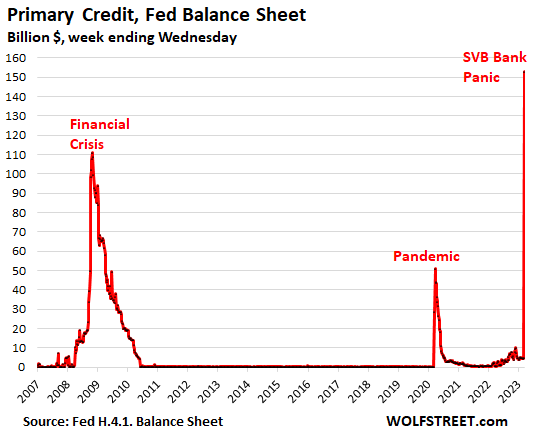Fed Loaned $160 Billion to Banks and $142 billion to FDIC. But QT-Related Roll-off Continued
At around 4.75%, plus collateral, these are expensive loans for banks.
By Wolf Richter for WOLF STREET.
The Fed’s balance sheet through Wednesday, released today, shows to what extent the Fed has provided emergency loans at around 4.75% interest and against collateral to US banks; and how much it loaned to the FDIC which is tasked with bailing out all depositors at Silicon Valley Bank and at Signature Bank, which collapsed last Friday and over the weekend.
At the same time, it shows that the QT-related roll-off of Treasury securities and MBS continued
“Keeping an eye on potential warning signs.”
My monthly updates on the Fed’s balance sheet have had for months a section, titled, “Keeping an eye on potential warning signs,” in anticipation of what would happen. And it happened.
The section discussed two accounts on the balance sheet that are unrelated to QT or QE, but are all about whether or not the banks are in trouble: “Primary Credit” (“Discount Window”) for banks in the US, and Central Bank Liquidity Swaps for banks in other countries for dollar liquidity.
On today’s balance sheet, there are two new accounts, the Bank Term Funding Program (BTFP) and “Other credit extensions” that were announced last Sunday as part of the liquidity support for banks and the depositor bailout with the FDIC.
Discount Window: $153 billion. This Primary Credit, as it’s called, allows banks to borrow at 4.75% currently, against collateral. It spiked by $148 billion, from $5 billion a week ago to $153 billion today, the biggest jump in the data.
This is expensive money for banks, and it requires collateral, and so banks won’t borrow long at this rate if they can avoid it, and they tend to pay back those loans quickly, as you can see from the chart below.
They borrowed this way because they needed to have the funds like “right now” when depositors were yanking their money out late last week and this week, as SVB Financial collapsed and panic spread.
But in relationship to the amount of overall deposits, the $153 billion is much smaller than during the financial crisis ($111 billion). In 2008, total deposits amounted to $6.7 trillion; at the beginning of March, total deposits were $17.6 trillion, over 2.6 times the level in 2008.

Bank Term Funding Program (BTFP): $12 billion. The new thingy that the Fed announced on Sunday. Under this program, the banks can borrow for up to one year, at a fixed rate for the term, pegged to the one-year overnight index swap rate plus 10 basis points, currently around 4.6%. Banks have to post collateral, which is valued at par.
But no, banks cannot play cute games with this: To be eligible per term sheet, the collateral has to be “owned by the borrower as of March 12, 2023.” So banks cannot buy securities at market price and post them as collateral at par.
The $148 billion increase in loans at the Discount Window and the $12 billion in BTFP funding amount to $160 billion in new loans that the banks have obtained from the Fed over the past seven days.
“Other credit extensions”: $142 billion. Loans to the new FDIC-owned banks that the FDIC set up to cover all depositors of collapsed Signature Bank and Silicon Valley Bank. The FDIC transferred all assets and deposits of the failed banks into these new banks. And it’s these FDIC-owned banks that borrow at the Fed, and they have to post collateral, while the “FDIC provides repayment guarantees.”
This amount is set to decline as the FDIC sells the assets and with the proceeds from the asset sales pays down the loans.
Central Bank Liquidity Swaps: $0.47 billion, no change. With this facility, central banks can swap local currency for USD to support their own banks if they need dollar liquidity.
Total loans to the banks and to the FDIC amount to $302 billion.
QT-related roll-off continued. Treasuries roll off twice a month, when they mature mid-month and at the end of the month. Today’s balance sheet captured the mid-month roll-off of $7.1 billion in three-year notes, which was the only security on the Fed’s balance sheet that matured. A big roll-off is coming at the end of the month.
MBS come off via pass-through principal payments, most of it near the end of the month, and some smaller movements during the month. The last big pass-through of principal payments occurred at the end of February and was booked in the week ended March 1. No large payment is expected until the end of March. A small amount, as is often the case in between the large payments, came off today ($1.3 billion).
Total assets on the Fed’s balance sheet increased by $297 billion.
Enjoy reading WOLF STREET and want to support it? You can donate. I appreciate it immensely. Click on the beer and iced-tea mug to find out how:

Would you like to be notified via email when WOLF STREET publishes a new article? Sign up here.
![]()
[ad_2]
Source link


